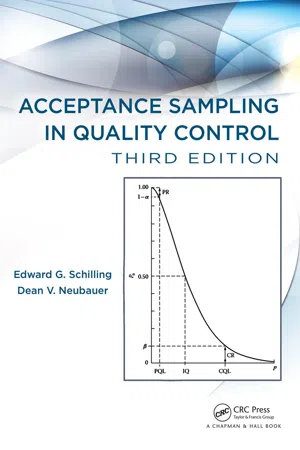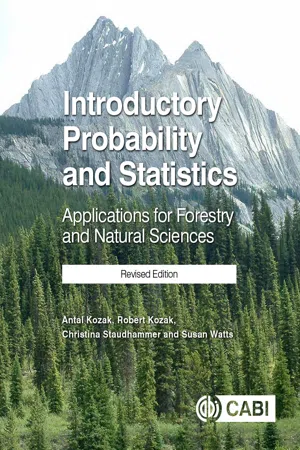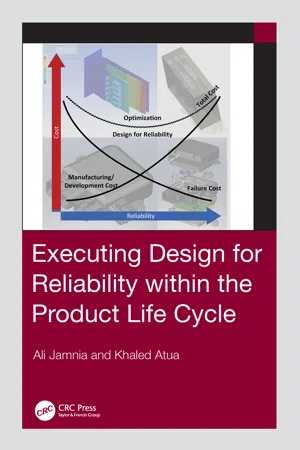Technology & Engineering
Hypergeometric Distribution
The hypergeometric distribution is a probability distribution that describes the number of successes in a sequence of draws without replacement from a finite population. It is commonly used in quality control, reliability engineering, and sampling inspection to calculate the probability of obtaining a specific number of defective items in a sample drawn from a larger population.
Written by Perlego with AI-assistance
Related key terms
Related key terms
1 of 4
Related key terms
1 of 3
3 Key excerpts on "Hypergeometric Distribution"
- eBook - ePub
- Edward G. Schilling, Dean V. Neubauer(Authors)
- 2017(Publication Date)
- Chapman and Hall/CRC(Publisher)
If possible, the reader should learn to use the tables cited or similar tables in conjunction with work in acceptance sampling. The small set of tables compiled by Odeh et al. (1977) will be found particularly useful. Many other tables present values of these and other probability distributions together with information useful in acceptance sampling. These include Owen (1962), Beyer (1968), and Burington and May (1970), among others. While computers and hand calculators will readily produce specific values, considerable insight into the nature of these distributions can be had by reference to these tables. Furthermore, the introductory material in the tables frequently contains information on the distributions not readily available elsewhere.Useful Approximations
The complexity of the Hypergeometric Distribution, and to some extent the binomial, makes it necessary to approximate these distributions at times with other, more tractable distributions. Fortunately, rules have been derived, that, when adhered to, ensure that reasonably good approximations will be obtained. Naturally, such rules depend upon just how close one distribution is expected to come to another. A schematic chart showing some distribution functions approximating the hypergeometric and the binomial distributions is presented in Figure 3.9 .FIGURE 3.9 Distributions approximating the hypergeometric and binomial. (Note: For a population of size N containing M defectives, p = M/N, and q = 1 – M/N.)The hypergeometric may be approximated by the ordinary p-binomial when the sample size is less than 10% of the population size. When the sample represents more than 10% of the population, the f-binomial may be used for calculations involving a proportion defective, p < .10. The f-binomial is the standard p-binomial with the sampling proportion f = n/N used as p and the number of defectives in the population Np used as the sample size n. The frequency function then becomesf( x )=C xN p(xn N)(1 −)n NN p − xProbabilities may be obtained using tables for the standard p-binomial withp =n Nn = N pThe rationale for the f - eBook - ePub
Introductory Probability and Statistics
Applications for Forestry and Natural Sciences (Revised Edition)
- Robert Kozak, Antal Kozak, Christina Staudhammer, Susan Watts(Authors)
- 2019(Publication Date)
- CAB International(Publisher)
Example 5.7. On the production line of a particular sawmill, it is known that lumber is classified into grade A, B and cull, in the following proportions: 1/5, 3/4 and 1/20. If we take 6 pieces randomly from the production line, what is the probability that 2 pieces will be grade A, 3 will be grade B and 1 will be a cull?Intuitively, we would expect this probability to be very small. It is indeed a very tall order to obtain exactly two pieces of one grade, three of another, and one of a third. In fact, this is the case for many discrete probability distributions and in answering these sorts of questions, you would be well advised to ask yourself if the result makes sense.5.3 Hypergeometric and Multivariate Hypergeometric Distributions
The Hypergeometric Distribution , like the binomial distribution, has two kinds of outcomes. However, it is different from the binomial distribution in its underlying assumptions: the probability of success from trial to trial is not constant and the successive trials are not independent. Hypergeometric trials are made without replacement from a finite population and thus the binomial distribution does not give correct probabilities. To illustrate the difference between binomial and Hypergeometric Distributions, we will turn back to Example 3.23 (see Chapter 3 ). We drew 2 cards from a deck of 52 cards and calculated the probability that they were both spades. As described in Chapter 3 , this experiment can be conducted with or without replacement. In an experiment with replacement, a card is drawn, observed and then put back into the deck, which is shuffled before a second card is drawn. This is a binomial experiment, since the probability of drawing a spade in the first draw is the same (13/52 = 1/4) as in the second draw, and the outcome in the second draw is independent of the first. In an experiment without replacement, one card is drawn, observed, put aside and then the second card is drawn from the remaining 51 cards. This is a hypergeometric experiment, since the probability of the second outcome is affected by the first outcome. The probability that the second draw (from only 51 cards) is a spade depends on whether or not the first card (drawn from a full deck of 52 cards) is a spade. In this example, and in all hypergeometric experiments, the probabilities for the second draw are conditional probabilities. The probabilities associated with drawing 2 cards that are spades (S ) or non-spades (N ) are illustrated in Fig. 5.2 . To calculate the probabilities associated with the hypergeometric experiment, a tree diagram is used; for the binomial experiment, Eqn 5.2 - Ali Jamnia, Khaled Atua(Authors)
- 2019(Publication Date)
- CRC Press(Publisher)
Hypergeometric Distribution is another model that can be used in calculating the probability of failure of single-use items. For example, small shipments of disposable medical kits to patients in rural and remote areas can have no more than the allowable number of defected sets in each shipment. Suppose that a manufacturer has started a new line of products that exhibit 5% defect in each batch of product being shipped to customers. On the one hand, if the customer uses five units every week, it is possible that five defective units are encountered. On the other hand, it is quite likely that the five units are all functioning as expected. Hypergeometric Distribution enables one to calculate the probability of encountering a defective unit in the selected set.This model is expressed as follows:P ( k ) =DkN − Dn − kNnwhere P (k ) is the probability of encountering k number of events. N is the population size or the total number of outcomes. K is the number of observed events or outcomes. D is the number of defected events in the population. n is the number of executed trials before k events or outcomes are observed.Notice that this distribution is different from the binomial distribution in that the probability of an undesired event is changing with every trial. What we mean is that once a sample is selected (whether it includes any defects or not), it is not returned back to its population. As a result, the unit pool gets smaller as more and more samples are drawn.Example
A service technician conducts maintenance of vending machines at different customer sites. Sometimes, he has to install a new rechargeable lead acid battery on these machines if the existing battery is not at its proper remaining capacity. This activity is time-consuming, as it requires a partial disassembly of the housing.The technician’s truck has a compartment to store ten batteries. However, on average four out of ten batteries lose their charging capacity due to age or weather conditions. The only time that this defect is discovered is when the battery is installed and the unit is tested. On average, the technician changes seven batteries a week. On a weekly basis, he replenishes his truck’s inventory of parts to be replaced including the batteries.
Index pages curate the most relevant extracts from our library of academic textbooks. They’ve been created using an in-house natural language model (NLM), each adding context and meaning to key research topics.
Explore more topic indexes
Explore more topic indexes
1 of 6
Explore more topic indexes
1 of 4


